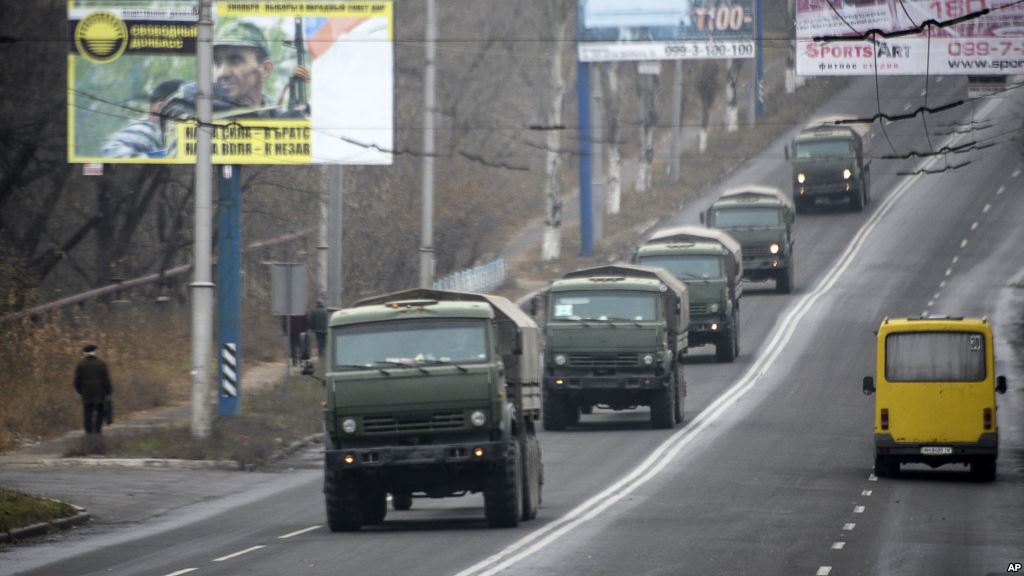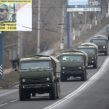
Ukrainian Crisis Fails to ‘Freeze’ as War of Attrition Continues
Publication: Eurasia Daily Monitor Volume: 11 Issue: 203
By:

The wobbly ceasefire in Donbas (region of eastern Ukraine, encompassing Luhansk and Donetsk provinces), undermined by constant shelling and fighting, seems to be on the verge of total collapse. Both sides (Ukrainian government and Russia-backed rebels) blame each other; the West blames Moscow and Moscow blames the West in acrid verbal exchanges, reminiscent of the worst days of the previous Cold War. The authorities in Kyiv accused Moscow and its protégées in Donbas of deliberately sabotaging the ceasefire agreements signed in Minsk last September. “Russia did not take a single step to help implement the ceasefire,” announced a Ukraine government spokesman, “Russia does not seek de-escalation, it wants chaos and lawlessness to prevail, for Ukraine to be economically warn-out, undermining our independent pro-European foreign policy” (Interfax, November 4).
Indeed, preventing Ukrainian integration into European security, economic and political institutions is the essence of Moscow’s long-term strategy. Kyiv must stay within Russia’s sphere of influence, totally separate from the North Atlantic Treaty Organization (NATO) and the European Union. The present Ukrainian upheaval following the overthrow of the corrupt regime of former president Viktor Yanukovych is seen in Moscow as a plot inspired by the United States to turn Ukraine into a strategic forward bridgehead, a base for a sudden all-out assault directly on Moscow that must be resisted at all costs. Under President Vladimir Putin, the Kremlin seems ready to do what it takes to prevent Ukraine from going West; but this goal may be achieved using differing tactics. According to former prominent United Russia party Duma deputy and the director of the Institute for Commonwealth of Independent States (CIS) Countries, Konstantin Zatulin, it would be preferable for Moscow to keep the Donbas separatists—the so-called “Novorossyia” (“New Russia”)—legally within Ukraine together with other predominately Russian-speaking eastern and southern regions like Kharkiv and Odesa. “Without Crimea and Donbas, Ukraine will turn into an anti-Russian state, which is unacceptable,” insists Zatulin (gazeta.ru, November 5).
The authorities in Kyiv understand the need to rearm, reform and modernize the national armed forces before attempting any move to flush out the rebels. The Kremlin, in turn, is clearly hesitant to begin an undisguised invasion of Ukraine, which could trigger more punitive Western sanctions. Russian public opinion, too, is opposed to such an intervention. According to a recent Levada Tsenter poll, a majority (55 percent) continue to support the annexation of Crimea and fully believe the biased Russian TV propaganda. Still, a clear majority (68 percent) seem to be against the deployment of regular Russian troops in battle in southeastern Ukraine to help the rebels (Nezavisimaya Gazeta, November 10).
Moscow and Kyiv, though for differing reasons and pursuing opposite strategic objectives, seem to have been ready to live with a sustainable ceasefire in the Donbas, but the rebels do not want the Minsk agreements to stand. The rebels do not seem content to just hold the war-ravaged part of Donbas they gained, and their leaders have been talking about moving on to “liberate” other cities in Donbas and beyond (Interfax, October 23). They have been constantly trying to push back the Ukrainian forces in local clashes in different parts of the line of control, according to observers from the Organization for Security and Cooperation in Europe (OSCE) (Interfax, November 12). But meanwhile, the separatist forces have been preventing the OSCE from controlling the 400-kilometer-long Ukrainian-Russian border in Donbas. The rebels are constantly accusing the Ukrainian military of launching a new overall offensive and are, apparently, trying to provoke the regular Russian military to move in directly—as they did at the end of August to prevent the fall of rebel-held Donetsk and Luhansk. Russian Foreign Minister Sergei Lavrov, in talks with his US counterpart, Secretary of State John Kerry, in Beijing, announced: “An attempt to use force to solve the crisis in Ukraine is unacceptable.” According to Lavrov, the West must put pressure on Kyiv not use the ceasefire to prepare its forces for further action (Rossyskaya Gazeta, November 8).
The Kremlin is committed to do what it takes to prevent a military defeat of the rebels—a commitment the rebels are today trying to exploit. On November 6, the rebels claimed Ukrainian armor had begun a massive offensive (Interfax, November 6). This claim was false, but Russia did react by sending reinforcements into Donbas to back the rebels up. OSCE observers, supported by Western journalists, have been reporting in recent days the presence of columns of newly-painted military vehicles towing heavy guns and armor on the roads of Donbas (osce.org, November 11). It is not clear whether these artillery and armor units on the move are regular Russian units or volunteers and rebels freshly armed by Russia. According to Ukrainian officials, the possibility of an offensive by rebels in Donbas backed up by Russian arms is high, but the present quantity of men and weapons deployed in Donbas “is not sufficient to mount a massive offensive” (newsru.ua, November 12).
The Donbas separatists lack numbers, weapons and organization to rout the Ukrainians on their own or with only partial, undercover Russian assistance; but the time of year is absolutely wrong for a massive offensive or invasion of Ukraine by Russian troops. It is, currently, mid-autumn with frequent rain, snow, fog and low cloud cover. The capability of troops and military vehicles to move off-road is hampered, and air support is ineffective. Additionally, the Russian military is in the midst of a call up of some 150,000 new conscript soldiers and the demobilization of the same number of soldiers that have served out one year of compulsory service. As this massive rotation of servicemen is underway, the Russian military will be struggling to muster a massive force of tens of thousands of men and hundreds of tanks and other heavy weapons to invade Ukraine. After New Year’s, the frost will turn the dirt in the fields into solid ice and the Russian conscript rotation will be finished. At that point, a new massive concentration of Russian combat troops will again be possible on the Ukrainian border—much like the one that was ordered last February, under the pretext of exercises, just before the invasion of Crimea (Rossyskaya Gazeta, February 26). By the end of March 2014 there were some 83,000 Russian servicemen on the border and in Crimea (newsru.ua, March 24). Until early next year, however, an escalating war of attrition in Donbas is possible and probably inevitable, as the likelihood of a relatively stable “frozen conflict” on the ground continues to fade away.




